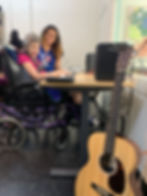Jargon and vernacular are ever evolving and frequently changing, especially over the past few years. In the disability community there is strong discussion of the merits between using person-first and identity-first language. There lies the question of which set of language is most inclusive and non-isolating. Often there is not a clear-cut answer as to which is correct, but instead we respect each person’s individual language preference. It is important to remember that there are no two people who are exactly the same, with their language, identity, and disability.

What is person-first language?
Person-first language puts the individual before the diagnosis, for example “I am a person with Down syndrome”, “She is a person who has ADHD”, or “They are a someone who uses a wheelchair”. The original idea of person-first language is that it will do away with labels and adjectives, gearing conversations and mindsets to focus on the individuals, not the disability. Person-first language is almost always used in clinical settings and regional centers.
What is identity-first language?
Identity-first language sets the diagnosis before the person, for example “a Deaf child”, “an Autistic individual”, or “a wheelchair user”. Those who prefer identity-first language recognize disability as inherently a part of the individual and that one’s diagnosis is not separate from a person’s identity. Many contemporary self-advocates and disability-centered influencers prefer and argue the case for identity-first language.

Which is the best terminology to use?
Because there are many differing opinions and reasons for using both person-first and identity-first language, we believe the best practice is to ask each individual how they identify. This is a sensitive and personal topic, so there isn’t necessarily a correct answer.

What do other people have to say?
Lydia Brown, Autistic Self Advocacy Network (ASAN) intern, wrote the following about their preference for identity-first language in their article The Significance of Semantics: Person-First Language: Why it Matters:
“…When we say "Autistic person," we recognize, affirm, and validate an individual's identity as an Autistic person. We recognize the value and worth of that individual as an Autistic person -- that being Autistic is not a condition absolutely irreconcilable with regarding people as inherently valuable and worth something. We affirm the individual's potential to grow and mature, to overcome challenges and disability, and to live a meaningful life as an Autistic. Ultimately, we are accepting that the individual is different from non-Autistic people--and that that's not a tragedy, and we are showing that we are not afraid or ashamed to recognize that difference.”
In 1983, activists during the beginning of the HIV/Aids crisis made one of the first statements demanding person-first language in the Denver Principles as a way to be recognized as a person rather than a victim:
“We condemn attempts to label us as “victims,” a term which implies defeat, and we are only occasionally “patients,” a term which implies passivity, helplessness, and dependence upon the care of others. We are “People With AIDS.”
The National Center on Disability and Journalism has created a Disability Language Style Guide where they give advice and suggestions on the best language use for a wide variety of disability related topics and diagnosis. This is what they say about person-first and identity-first language:
“People-first language avoids defining people in terms of their disability. In most cases, this entails placing the reference to the disability after the reference to a person… People-first language is not preferred by all people with disabilities. Specifically, some members of the autism and Deaf communities prefer identity-first language. Ask the person with a disability how they prefer to be described; if that’s not possible, ask a spokesperson for the organization representing the relevant disability for preferred terminology.”

What language do we use at Able ARTS Work, Learn for Life?
We will always use a person’s preferred identity choice when it has been made known to us. We will also always ask for their identity preferences. When an individual has not made their preferred terminology known, we currently continue to use person-first as it is generally considered to be standard etiquette. However, due to the changing nature of language and advocacy, we are constantly paying attention to the needs of the community, are aware of the complex and sensitive nature of this topic, and are open to discussion, learning, and change. We recognize a person-first approach does not suit everyone across the board.

Ultimately, what you should take away from this is that everyone has the right to choose how they want to be identified, and there are benefits to both language choices. As this is an ever-evolving situation, it is important to listen to the community and be willing to adapt and change with different situations and needs.
Want to hear read more about inclusive language? Read Part One and Part Two of Occupational Therapist and Disability Advocate Sarah Tuberty’s interview with us about rewriting the disability narrative and how to be a part of the conversation and movement.
We always appreciate feedback from the community. If you have suggestions, ideas, or questions about inclusive language or our usage of it, please feel free to reach out to us at learnforlife@ableartswork.org.

Sydney Davis-Campos is the Virtual Learning Coordinator at Able ARTS Work, Learn for Life. She has a B.A. in Studio Art and Art History. Sydney has worked at Able ARTS Work for almost 5 years where she has also held the positions of Art Instructor and an Assistant Program Manager.
Sources:
“Disability Language Style Guide.” National Center on Disability and journalism. Accessed October 8, 2021. https://ncdj.org/style-guide/ .
Brown, Lydia. “Identity-First Language.” Autistic Self Advocacy Network. Accessed October 8, 2021. https://autisticadvocacy.org/about-asan/identity-first-language/ .
Brown, Lydia. “The Significance of Semantics: Person-First Language: Why It Matters.” Autistic Hoya - A blog by Lydia X. Z. Brown, 2011. https://www.autistichoya.com/2011/08/significance-of-semantics-person-first.html .
Callahan, Molly. “The Autistic, Non-Binary, Queer, Law Student Fighting for Disability Justice.” News @ Northeastern, April 23, 2020. https://news.northeastern.edu/2018/04/19/the-autistic-non-binary-queer-law-student-fighting-for-disability-justice/ .
Conlin, Matthew. “Person-First Language vs. Identity-First Language: An Examination of the Gains and Drawbacks of Disability Language in Society.” Journal of Teaching Disability Studies, January 3, 2019. https://jtds.commons.gc.cuny.edu/person-first-language-vs-identity-first-language-an-examination-of-the-gains-and-drawbacks-of-disability-language-in-society/ .
Haelle, Tara. “Identity-First vs. Person-First Language Is an Important Distinction.” Association of Health Care Journalists, July 31, 2019. https://healthjournalism.org/blog/2019/07/identity-first-vs-person-first-language-is-an-important-distinction/ .
Lynch, C.L. “Person-First Language: What It Is, and When Not to Use It.” NeuroClastic, May 13, 2020. https://neuroclastic.com/person-first/ .
The Advisory Committee of the People With AIDS. “The Denver Principles 1983 - UNAIDS,” 1983. https://data.unaids.org/pub/externaldocument/2007/gipa1983denverprinciples_en.pdf .



